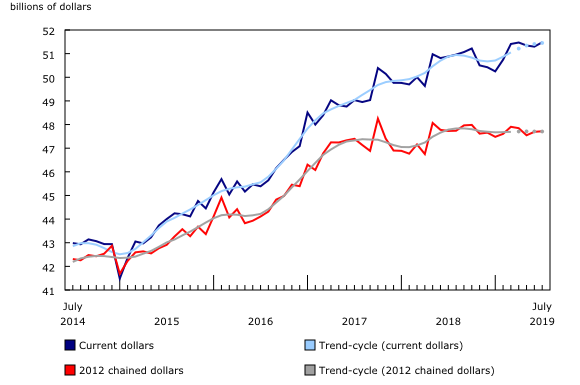Retail trade, July 2019
Archived Content
Information identified as archived is provided for reference, research or recordkeeping purposes. It is not subject to the Government of Canada Web Standards and has not been altered or updated since it was archived. Please "contact us" to request a format other than those available.
Released: 2019-09-20
$51.5 billion
July 2019
0.4% 
(monthly change)
$0.7 billion
July 2019
1.1% 
(monthly change)
$0.2 billion
July 2019
-0.0% 
(monthly change)
$1.4 billion
July 2019
0.2% 
(monthly change)
$1.1 billion
July 2019
-2.7% 
(monthly change)
$10.9 billion
July 2019
-0.4% 
(monthly change)
$19.6 billion
July 2019
1.2% 
(monthly change)
$1.8 billion
July 2019
0.6% 
(monthly change)
$1.6 billion
July 2019
0.9% 
(monthly change)
$6.8 billion
July 2019
0.7% 
(monthly change)
$7.1 billion
July 2019
-0.8% 
(monthly change)
Sales in the retail trade sector advanced for the first time in three months, increasing 0.4% in July to $51.5 billion. Higher sales were reported in 6 of 11 subsectors representing 71% of retail trade.
After removing the effects of price changes, retail sales in volume terms were essentially unchanged in July.
Higher sales at motor vehicle and parts dealers; cannabis store sales top $100 million
Sales at motor vehicle and parts dealers advanced 1.5% in July, their largest increase since February. The increase stemmed from higher sales at new car dealers (+2.4%), which more than offset lower sales at automotive parts, accessories and tire stores (-2.4%), other motor vehicle dealers (-2.3%) and used car dealers (-1.0%).
Rising for the fifth time in six months, sales at both health and personal care stores (+2.6%) and food and beverage stores (+0.6%) were up in July. In the food and beverage stores subsector, higher receipts at supermarkets and other grocery stores (+0.9%) led the gain.
Miscellaneous store retailers were up 1.7% in July, bolstered by higher sales at cannabis stores (+14.3%). Sales at cannabis stores exceeded $100 million for the first time. Gains at cannabis stores were widespread, and across all provinces, with double-digit growth reported in eight provinces. Throughout July, there were over 300 cannabis stores in operation across Canada, a number that has more than doubled since legalization in October 2018.
Following a 3.7% decline in June, retail sales at gasoline stations edged up 0.3%, fuelled by higher prices. According to the Consumer Price Index, the price of gasoline in July was up 3.3% on an unadjusted basis. In volume terms, gasoline sales declined 1.5%.
Sales at building materials and garden equipment and supplies dealers decreased 3.2% after increasing 5.0% in June. Sales in this subsector remained above the level observed in May.
Sales up in six provinces and all census metropolitan areas
Provincially, retail sales were up in six provinces, with the largest increases observed in Ontario and, to a lesser extent, the Prairie provinces.
After a relatively flat month in June, retail sales in Ontario (+1.2%) picked up in July. Sales in the census metropolitan area (CMA) of Toronto were up 1.1%.
In Alberta (+0.7%), retail sales were up for the first time in three months as a result of higher sales at motor vehicle and parts dealers.
Retail sales advanced in both Saskatchewan (+0.9%) and Manitoba (+0.6%) in July. The gain in Manitoba coincided with a percentage point reduction in the provincial sales tax, effective July 1, 2019.
In Quebec, retail sales were down 0.4% despite higher sales in the CMA of Montréal (+0.5%).
Lower sales were reported in British Columbia (-0.8%). However, sales in the CMA of Vancouver rose 0.5%.
E-commerce sales by Canadian retailers
The figures in the following sections are based on unadjusted (that is, not seasonally adjusted) estimates.
On an unadjusted basis, retail e-commerce sales were $1.8 billion in July, accounting for 3.2% of total retail trade. On a year-over-year basis, retail e-commerce increased 32.8%, while total unadjusted retail sales were up 3.7%.
Note to readers
All data in this release are seasonally adjusted and expressed in current dollars, unless otherwise noted. For information on seasonal adjustment, see Seasonally adjusted data – Frequently asked questions.
For information regarding cannabis statistics, consult the Cannabis Stats Hub.
Seasonally adjusted estimates for cannabis store retailers are presented in unadjusted form as there is no seasonal pattern established by official statistics yet. Establishing such a pattern requires several months of observed data. In the interim, the seasonally adjusted estimates for cannabis store retailers will be identical to the unadjusted figures.
Statistics Canada's retail e-commerce figures include the electronic sales of two distinct types of retailers. The first type do not have a storefront. These businesses are commonly referred to as pure-play Internet retailers and are classified to North American Industry Classification System (NAICS) 45411—Electronic Shopping and Mail Order Houses. The second type have a storefront and are commonly referred to as brick-and-mortar retailers. If the online operations of a brick-and -mortar retailer are separately managed, they too are classified to NAICS 45411.
Some common electronic commerce transactions, such as travel and accommodation bookings, ticket purchases, and financial transactions, are not included in Canadian retail sales figures.
For more information on retail e-commerce in Canada, see "Retail E-Commerce in Canada."
Total retail sales expressed in volume terms are calculated by deflating current dollar values using consumer price indexes. The retail sales series in chained (2012) dollars is a chained Fisher volume index with 2012 as the reference year. For more information, see Calculation of Volume of Retail Trade Sales.
For information on trend-cycle data, see the StatCan Blog and Trend-cycle estimates – Frequently asked questions.
Real-time tables
Real-time tables 20-10-0054-01 and 20-10-0079-01 will be updated on September 30.
Next release
Data on retail trade for August will be released on October 22.
Contact information
For more information, contact us (toll-free 1-800-263-1136; 514-283-8300; STATCAN.infostats-infostats.STATCAN@canada.ca).
For analytical information, or to enquire about the concepts, methods or data quality of this release, contact Elizabeth Chretien (613-951-0027; elizabeth.chretien@canada.ca), Retail and Service Industries Division.
- Date modified:


